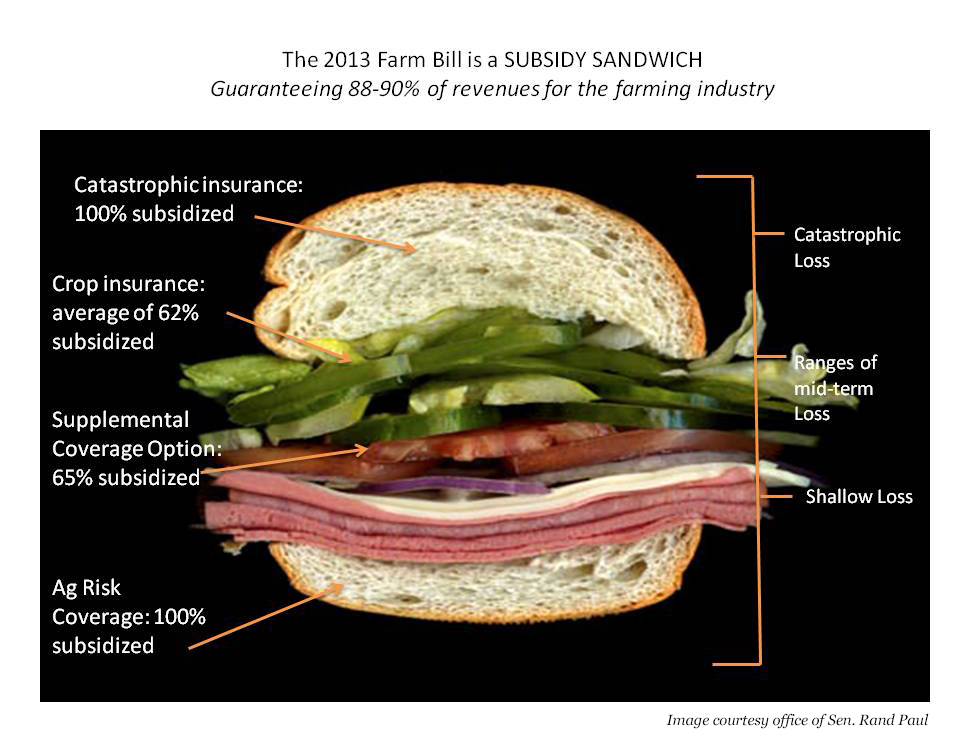Volume XVIII No. 21:
This week’s Wastebasket is part two of two. Last week, we analyzed the “Rear View Farm Bill” being considered in the U.S. Senate. This week, we dive into the federal crop insurance program to show how taxpayer dollars can be saved.
Crop insurance – the most expensive taxpayer support in Washington’s bloated agriculture policy – was placed in the hot seat this week. As the Senate began to consider a new trillion dollar farm bill, amendments from lawmakers across the political spectrum sprang up. Whether they represented states with an abundance of corn or coal, crop insurance was a popular focus.
It’s not surprising crop insurance is under the microscope. The highly subsidized federal program covering everything from almonds to oysters cost taxpayers a record $14 billion last year and is projected to cost $90 billion over the next decade. On a basic catastrophic policy, covering a 50 percent loss, Uncle Sam picks up 100 percent of the cost. Most farm businesses “buy-up” to higher levels of coverage, and taxpayers generously cover an average 62 cents out of each dollar of these farmers' insurance premium costs. And policies pay not only on a loss of crops, but the revenue agribusinesses expected. Hence, taxpayer dollars end up propping up incomes even after bountiful harvests, if prices dip.
Thankfully, a few brave Senators stood up to the agribusiness and crop insurance lobbies this week offering ways to reduce crop insurance’s out-of-control cost while shifting unnecessary risks off taxpayers’ backs. Some of these improvements include:
- Sens. Durbin (D-IL) and Coburn’s (R-OK) amendment to slightly reduce (by 15 percent) subsidies for any farm business with more than $750,000 in income, not counting the value of land and after taking into account write-offs and other adjustments.
- Sens. Feinstein (D-CA) and McCain’s (R-AZ) amendment to eliminate crop insurance subsidies for Joe Camel (tobacco growers).
- Sens. Toomey (R-PA) and Shaheen’s (D-NH) amendment to – for the first time in history – place a limitation on the amount of subsidies any one person can receive.
Senators smartly voted to accept the first, but just hours before, rejected an elimination of tobacco subsidies. Sens. Toomey and Shaheen will have to wait until the Senate comes back from vacation after Memorial Day to find out the fate of their amendment.
Unfortunately, crop insurance isn’t the only elephant in the room. Evidently the current generous subsidies aren’t enough for the farm lobby, so they crafted crop insurance on steroids. New potentially budget-busting entitlement programs called “shallow loss” will put salt on the taxpayer wound. They’re stacked on top of the free catastrophic and subsidized buy-up crop insurance, essentially ensuring that agribusinesses never experience more than a five to ten percent loss in expected revenue. This subsidy sandwich is a business cash guarantee unparalleled in any other industry. Sen. Flake (R-AZ) offered common sense amendments to eliminate two of the most egregious “shallow loss” programs – one for cotton and another targeted at more than 120 crops – that would increase the footprint of Washington in agriculture. Guaranteeing profits of agribusinesses was something the U.S. Department of Agriculture rejected nearly ten years ago for obvious reasons, but leave it to the crop insurance lobby to manufacture something just as distorting and pound it into law.
 Even if these and other pro-reform amendments pass, we’ll still be behind the curve in eliminating other special interest goodies that were added to the bill. Before the farm bill hit the floor, Senate Agriculture Committee members piled on more carve-outs for their special someones. Some of last year’s biggest winners were popcorn, peanuts, and poultry producers. They’re all still in the taxpayers-will-guarantee-your-expected-revenue club. And now they’re joined by businesses harvesting or raising seafood, Santa’s reindeer (farm-raised deer and elk), and sweet sorghum. So instead of just subsidizing the collection, storage, harvest and every other aspect of sweet sorghum production for biofuels, taxpayers will also cover the cost of production. Sweet indeed.
Even if these and other pro-reform amendments pass, we’ll still be behind the curve in eliminating other special interest goodies that were added to the bill. Before the farm bill hit the floor, Senate Agriculture Committee members piled on more carve-outs for their special someones. Some of last year’s biggest winners were popcorn, peanuts, and poultry producers. They’re all still in the taxpayers-will-guarantee-your-expected-revenue club. And now they’re joined by businesses harvesting or raising seafood, Santa’s reindeer (farm-raised deer and elk), and sweet sorghum. So instead of just subsidizing the collection, storage, harvest and every other aspect of sweet sorghum production for biofuels, taxpayers will also cover the cost of production. Sweet indeed.
Considering the lavish largesse already larded on agribusiness, Congress has to be ever more creative at finding ways to shovel cash to politically-popular farm country. If they instead directed half as much energy into developing a cost-effective, transparent, accountable, and responsive safety net, they’d still have enough time to do something about the $16.7 trillion debt and fix that pesky $1.2 trillion sequestration. Just sayin’.










